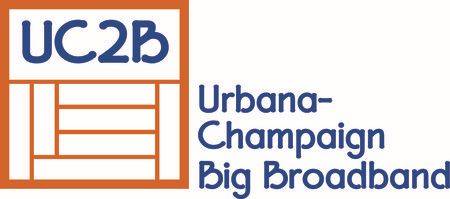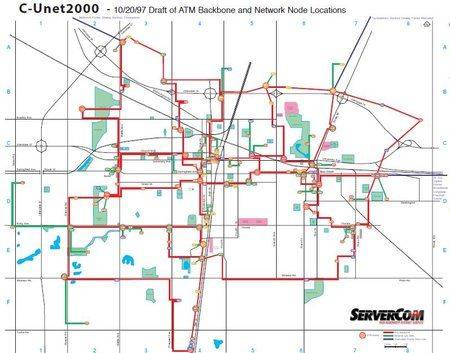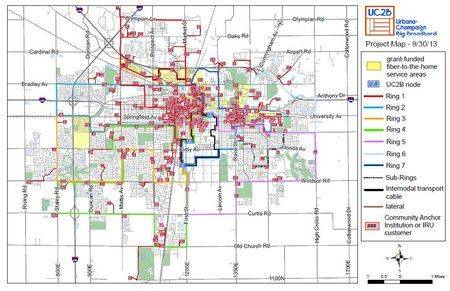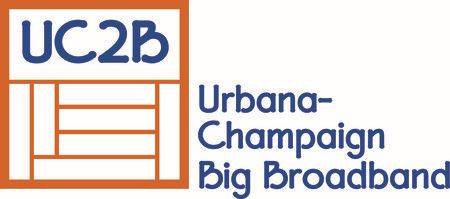 Urbana-Champaign Big Broadband (UC2B) is a much debated public project that sought optimistically to bring internet fiber lines to houses and businesses across the Champaign-Urbana area. It caught fire, then went cold, and for a number of months the UC2B website has provided the smallest of details about progress towards its goals.
Urbana-Champaign Big Broadband (UC2B) is a much debated public project that sought optimistically to bring internet fiber lines to houses and businesses across the Champaign-Urbana area. It caught fire, then went cold, and for a number of months the UC2B website has provided the smallest of details about progress towards its goals.
This is the first in a three-part series of articles about the origins, current state, and future direction on UC2B.
Origins of UC2B, with Mike Smeltzer
1997 – CCNet technical chair and local Internet business owner Mike Smeltzer proposes C-Unet-2000 to the Champaign City Council.
All talks of when and where the idea for UC2B began start with Mike Smeltzer. Although semi-retired since January 2014, he was the primary instigator for the UC2B project, a project that started in 1997 with C-Unet-2000, an ambitious plan to build fiber rings around the CU area in three years.
As it states on the UC2B website, he may have slightly underestimated the amount of time it would take to bring high-speed broadband fiber cable to all of CU.
But in his experience as the owner of an early company that offered internet services, the networks provided by the internet were crucial for organizations like banks, healthcare providers, and schools, all of which needed an easy and efficient way to share data.
His goal was to bring that to the community at large and it started with the University.
In 1999, the University of Illinois, CU, released an RFP seeking vendors to provide high speed internet connection to university housing, primarily fraternities and sororities at that time. Its vision was realized when in 2000 McLeod USA built a fiber network on the Champaign side of campus to serve those populations, along with other apartment buildings.

And then, like many projects, this one went cold. For seven years until the formation of the Broadband Access Committee (BAC) by the Champaign-Urbana Cable Commission in 2007, the prospect of bringing high speed internet access to all homes in CU remained elusive.
Then a series of events in early 2008 and 2009 set the wheels in motion to make Mike Smeltzer’s dream come true.
February 2008 – University of Illinois Director of Networking – Mike Smeltzer – attends an Educause presentation by John Windhausen who advocates a national fiber project to connect every home and business in the country to a publicly owned fiber network.
“What would happen if we put fiber in every house in America?”
That was the question John Windhausen posed during his presentation in February 2008, which Mike Smeltzer attended. The question formed the catalyst from which Smeltzer would form UC2B in the months to come, a process that included registering the domain name, drafting a proposal, and presenting the proposal to the BAC.
“What would happen if we put fiber in every house in America?”
The idea proposed by Windhausen included a three-fold plan, which Smeltzer later used in his proposal. Windhausen suggested using federal, state, and local government to fund the fiber projects, and Smeltzer realized he had three institutions in CU—the local governments and the University.
“Fiber is 10-15 year investment, a great investment in the long-term,” Smeltzer said. “We needed institutions with a long perspective that would do what was good for society even if wasn’t good right away.”
But even after presenting the concept to the BAC, there was the question of funding. The stroke of good luck of came at the “State of the Net” conference sponsored by the Congressional Internet Caucus in Washington D.C. in January 2009. He met Joanne Hovis, who would later tell a group during a presentation about the upcoming opportunities for Big Broadband from the upcoming economic stimulus bill.
“I took notes for about fifteen minutes,” Smeltzer said, “and the thought came: HIRE HER!”
 And so he did as a consultant. Fast-forward to the summer of 2009 when the ball gets rolling.
And so he did as a consultant. Fast-forward to the summer of 2009 when the ball gets rolling.
The UC2B Intergovernmental Consortium is proposed to both City Councils and the UIUC chancellor. Door-to-door surveys are conducted to determine which areas in CU are “underserved.” The UC2B Intergovernmental Agreement is voted on and approved by both City Councils.
Mike Smeltzer identified two specific areas that gave the UC2B team more trouble than expected. “There were the requirements from the federal grant and the public policies from the University and the State of Illinois. The public policies were cumbersome.”
Politics was surprisingly not much an issue.
“Regardless of being liberal, conservation, democrat, or republication, everyone responds to discussions of economic development,” Smeltzer said. “They respond to having jobs available locally for their kids, having a healthy economic environment.”
Work was done to make the application for funding as attractive to the Illinois Department of Commerce and Economic Opportunity and the NTIA. A team worked on creating an “above-ground” application for Public Computing Centers and Sustainable Broadband Adoption. Mike and his team worked on creating a “below-ground” application that focused on infrastructure.
The “below-ground” application won the money, $22.5 million from the NTIA, $3.5 million from the State of Illinois, and also raised $3.4 million locally in Champaign-Urbana.
December 6, 2010 – The University executes contract with Shive-Hattery for UC2B fiber engineering.
And then the construction started. According to the UC2B website, there are seven UC2B fiber rings, and each of the seven fiber rings has hundreds of fiber strands. Each pair of fiber strands can support a separate physical network, which means that the seven fiber rings can perform multiple functions and have unlimited flexibility for the future.
Mike Smeltzer stated that one of the toughest challenges in the entire project was working with the contractors. “Sometimes you’d end up with contractors you’d not like to be working with, all things considered.”
The requirements stipulated by the federal grant were worked on during the final few months of 2013. In the end, Mike Smeltzer realized his goal.

“If you look at the original C-Unet-2000 map of the rings and look at the map of the rings for UC2B, they’re remarkably similar,” Smeltzer said. “The vision for UC2B was to put fiber in front of every house and business in this community.”
The capability and infrastructure are there but now there’s an issue of how to fund UC2B after the grant money runs out. They’re working on bringing in a private company to run the business aspect of UC2B and may or may not be close to achieving that.
Mike Smeltzer won’t say. “We’ve all signed nondisclosure agreements,” he said, smiling.
The semi-retired former Director of Networking for the UIUC still has his contacts but he’s remaining tight-lipped on this one. An announcement may come in a few weeks or a few months down the road. It’s impossible to say.
But he has realized one thing — Big Broadband has come to CU.








